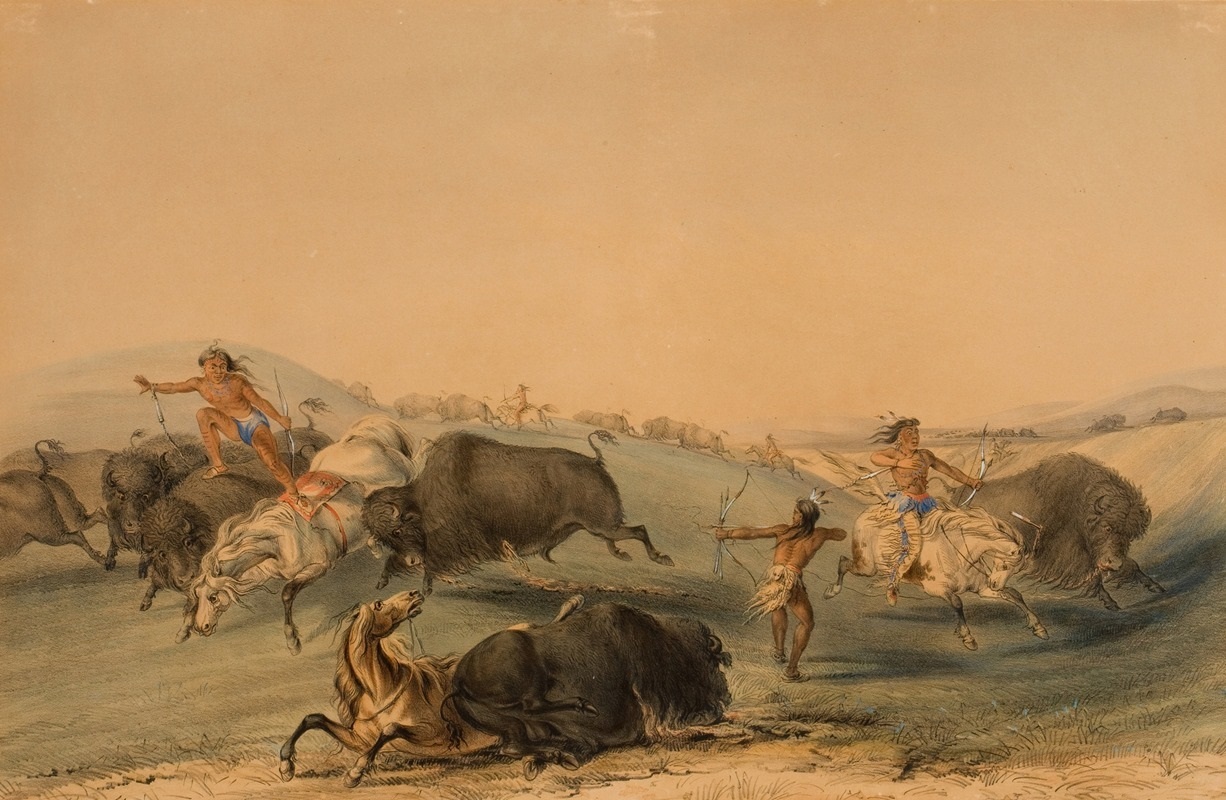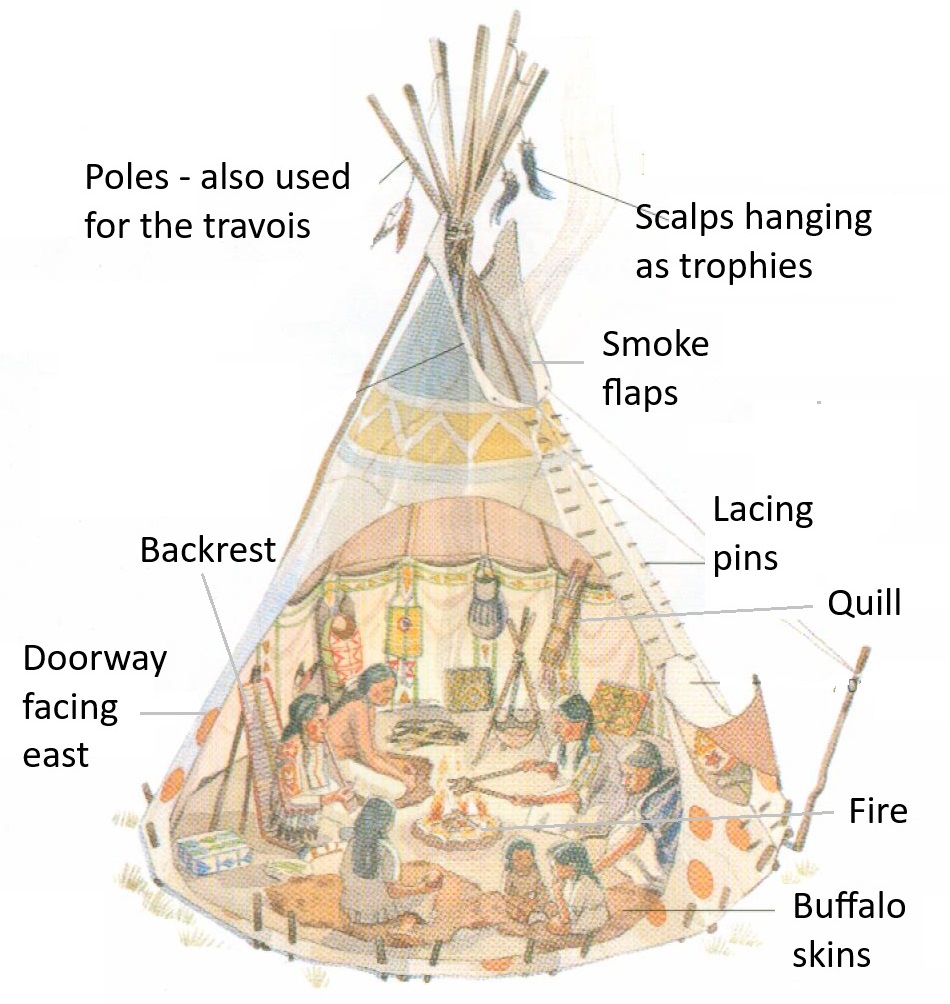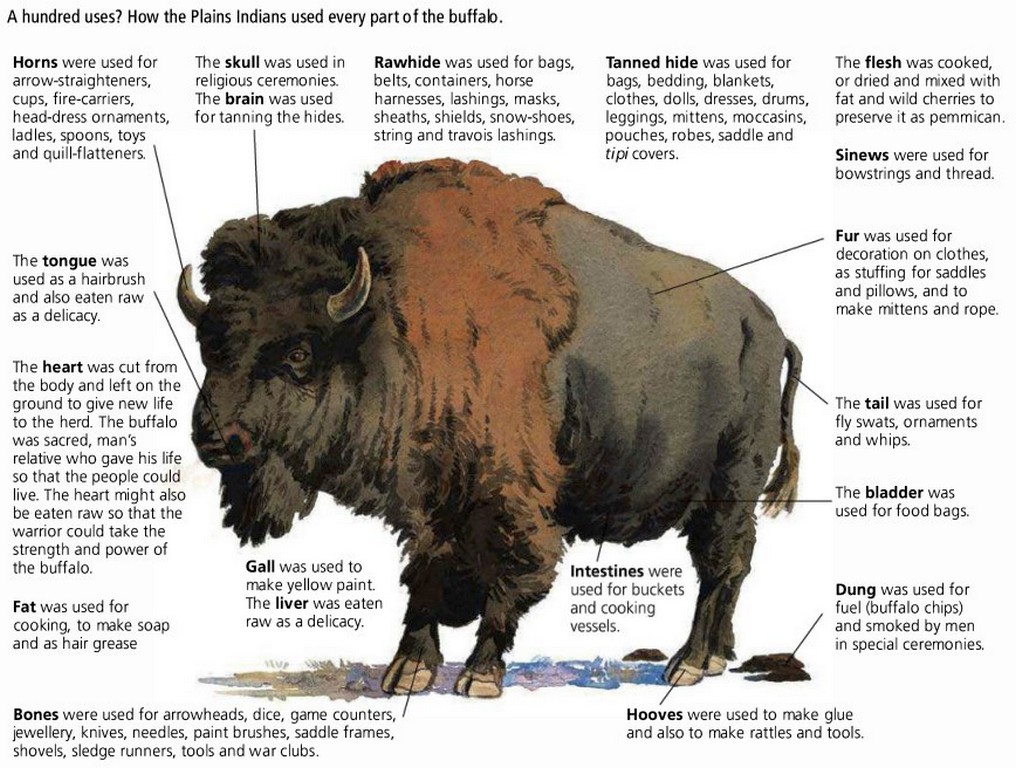|
|
|
|
This coloured print of an 1832 lithograph by George Catlin depicts a chase in the Upper Missouri region where the SIoux lived, and appears to be an illustration to accompany Catlin's description of a Sioux hunt.
|
Going DeeperThe following links will help you widen your knowledge: White Americans' attitudes - BBC Bitesize The place of Indigenous women - teachit exercise
YouTube Mr Cloke's Rapid Revision video is a useful summary overview
Consider:Writing in 1998, Martin & Shephard thought that Catlin's images were "obviously sympathetic towards the Indians", but felt that they could be misused "to portray Indians in a negative way - as savages", and that they presented "Plains Indian life as outsiders saw it". How valuable is Catlin, do you think, as a source on th Indigenous peoples' way of life?
|
|
The Indigenous Nations had LIMITED technology – some tribes were still using stone implements when the Europeans arrived in the 17th century. The tribes split into smaller bands (of about 400). The Sioux were nomadic. They lived in tipis made of buffalo skin, supported by wooden poles (easily assembled and dismantled). Camp could be broken in a few minutes; they put their belongings into buffalo skin bags called parflèches, on a travois made from the poles pulled by horses. They lived like this partly, because the Great Plains would not support their way of life for long, and to follow the buffalo migrations, but also because they believed that the Great Spirit wanted them to live a life of continual moving. They regarded a fixed home as a cage. For food, the Sioux were hunter-gatherers; they gathered maize, squashes, beans & turnips (although they asked permission before pulling them up). They hunted deer, rabbits, ducks, turkeys … and the buffalo. The Lakota Sioux year had 13 months, following the phases of the moon – with four months in the long winter:
The central event of their life was the buffalo hunt (on horseback), which was a whole-community event and involved great skill and danger. When the buffalo were killed a great delicacy was to eat the raw and still-warm liver and kidneys, and maybe the heart – offal did not keep for long on the Great Plains (no refrigeration). The buffalo supplied their needs; they did not need to farm. Men and women had clearly defined roles. Men (and women who refused to accept a womanly role) went off to the hunt and to war. Women (and any males too timid to go through initiation) gathered food, stayed at home and looked after the children. Children were never struck, and rarely disciplined. Sioux sports were functional and designed to help them survive in the Great Plains, and involved such activities as horse racing and shooting contests (firing as many arrows in the air at once, or when riding, dropping to the horse's side) which prepared them for war and the buffalo hunt. The women spent their leisure time decorating their clothes and tipis (tents) with beads and quills (religious meaning).
Seven Ways the HORSE was vital to the Sioux Way of Life • The horse was essential to their nomadic lifestyle – they dragged their possession on poles pulled by horses. • The horse was essential to all travel on the Great Plains – e.g. as they went to hunt or to war. • They hunted the buffalo on horseback. • The aim of war was to capture horses and to show bravery. • Their currency was horses. • A youth could pay a dowry of horses and take his bride • Horse stealing from other tribes was admired.
|
Six reasons the Sioux lived in tipis
Source AA beautiful tipi is like a good mother. She hugs her children to her and protects them from heat and cold, snow and rain. Sioux proverb
Source B[The tipi] is usually in cold weather too full of smoke to be bearable to anyone but an Indian.... In this small space are often crowded eight or ten persons, possibly three or four different families. Since the cooking, eating, living and sleeping are all done in the one room, it soon becomes unbelievably filthy. Colonel Richard Dodge, Hunting Grounds of the Great West (1877). Dodge was a cavalry colonel who – accompanied by Gerge Catlin – led an expedition in 1834 to establish friendly contact with the Comanche Nation. He saw the Indigenous people through his eyes as an army officer and, suggested Martin & Shephard, "did not wholly understand them". |
|
The Lakota Sioux word for buffalo is tȟatȟáŋka (or 'tatanka').
Source C
|
Consider:Looking back at this and the two previous webapges on the Sioux way of life, make lists of many as you can find of the following (if you click on the u you will be able to see my suggestions):
|
Source DBoth he and his wife, like most other Indians, were very fond of their children, whom they indulged to excess, and never punished, except in extreme cases when they would throw a bowl of cold water over them. Their offspring became sufficiently undutiful and disobedient under this system of education, which tends not a little to foster that wild idea of liberty and utter intolerance of restraint which lie at the very foundation of the Indian character. It would be hard to find a fonder father than Kongra-Tonga... In his capacity of husband he was somewhat less exemplary. The wife who lived in the lodge with him had been his partner for many years. She took good care of his children and his household concerns. He liked her well enough, and as far as I could see they never quarreled; but all his warmer affections were reserved for younger and more recent favorites. Of these he had at present only one, who lived in a lodge apart from his own. One day while in his camp he became displeased with her, pushed her out, threw after her her ornaments, dresses, and everything she had, and told her to go home to her father. Having consummated this summary divorce, he came back, seated himself in his usual place, and began to smoke with an air of utmost tranquillity and self-satisfaction.. Francis Parkman, The Oregon Trail (1849), describing the family life of Sioux Chief Big Crow. Parkman was a rich American who spent seven months with the Sioux. His account read more like a novel than a description, and Martin & Shephard (1998) suggested that his book was "based on a very limited experience and coloured by his own prejudices."
Source EThe Indians are children. Their arts, wars, treaties, alliances, habitations, crafts, properties, commerce, comforts, all belong to the very lowest and rudest ages of human existence. As I passed over those magnificent bottoms of Kansas, constituting the very best corn-lands on earth, and saw their owners sitting around the doors of their lodges at the height of the planting season and in as good, bright planting weather as sun and soil ever made, I could not help saying, "These people must die out – there is no help for them. God has given this earth to those who will subdue and cultivate it… Briefly, the ‘brave’, whether civilized or savage, is not a worker, a producer … Squalid and conceited, proud and worthless, lazy and lousy, they will strut out or drink out their miserable existence, and at length afford the world a sensible relief by dying out of it. Horace Greeley, An Overland Journey, from New York to San Francisco in the Summer of 1859 Greeley was editor of the New York Daily Tribune, a member of Congress, and stood for President in the 1872 elections. He is credited with inventing the slogan: “Go West, young man!” During his journey he seems to have talked only to one Indigenous person, an Arapaho he called Left Hand, whom he tried, and failed, to persuade to set up a farm.
|
Consider:Nowadays, we find the content and tone of Source E deeply offensive. However, at the time, many white Americans, steeped in their European, urban, Christian, capitalist traditions, found many aspects of the Indigenous Nations' way of life incomprehensible and scandalous. Looking back at this and the two previous webapges on the Sioux way of life – especially studying the Sources – find aspects of Sioux culture which would have shocked white Americans, and why.
|
|
| |


